|
|
|
|
|
|
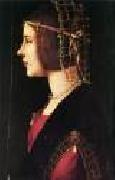 |
PREDIS, Ambrogio de
|
|
Italian Early Renaissance Painter, ca.1455-1508
Painter and illuminator, half-brother of Cristoforo de Predis. He began his career as an illuminator, working with Cristoforo. His first documented works are seven miniatures for a Book of Hours (1472; destr.) for Vitaliano Borromeo (1451-95) and a Book of Hours for Francesco Borromeo. He was paid for the latter in 1474, and the codex can probably be identified with the Horae Beatae Virginis Mariae (ex-H. P. Kraus, New York, 1987; Suida, 1959). From 1479 he artist worked in the Milanese mint, together with his brother Bernardino. For some years Giovanni Ambrogio also worked at the court of Ludovico Sforza ('il Moro'), especially as a portrait painter. This is borne out by the charcoal drawing of Bianca Maria Sforza (1492; Venice, Accad.), which dates from a period before her marriage to Emperor Maximilian I. The portrait was ordered by her future husband, through Frederick III, Duke of Saxony, to give him an idea of her appearance. It was favourably received, and later a painting of the same subject (Washington, DC, N.G.A.) was commissioned from Giovanni Ambrogio. |
|
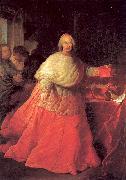 |
Procaccini, Andrea
|
|
Italian, 1671-1734
Italian painter, draughtsman and architect. A pupil of Carlo Maratti, he is first documented in 1702, among the restorers of Raphael's fresco decorations (1511-14) in the Vatican. His Tarquinius and Lucretia (c. 1705; Holkham Hall, Norfolk) has cold colours and unnatural gestures that recall Guido Reni. Appointed by Pope Clement XI, between 1710 and 1717 Procaccini supervised the tapestry factory in S Michele a Ripa: the Purification of the Virgin (Rome, Vatican, Consistory Hall) is the only extant tapestry made from a cartoon (untraced) by Maratti and an oil painting (untraced) by Procaccini. The Baptism of Cornelius Centurion (1711; Urbino, S Francesco) for the Baptism Chapel in St Peter's, Rome, was previously attributed to Maratti or Giuseppe Bartolomeo Chiari, but Procaccini apparently based it on sketches supplied by Maratti, who also supervised and revised the work before it was displayed. |
|
|
|
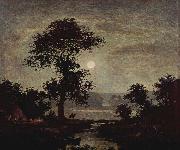 |
Ralph Albert Blakelock
|
|
(October 15, 1847 - August 9, 1919) was a romanticist painter from the United States.
Ralph Blakelock was born in New York City on October 15, 1847. In 1864, Blakelock entered the Free Academy of the City of New York (now known as the City College) with aspirations of becoming a physician. After his third term he opted to dismiss his formal education and left college. From 1869-71 he traveled west, extensively wandering far from known civilization and spending time among the American Indians. Largely self-taught as an artist, he began producing competent landscapes, depicting select views from his travels, as well as scenes of American Indian life. His works were exhibited in the National Academy of Design.
Moonlight, 1885, the Brooklyn MuseumIn 1877 Blakelock married Cora Rebecca Bailey; they had nine children. In art, Blakelock was a genius, yet, in business dealings and in monetary transactions he proved a failure. He found it difficult, if not crushing to maintain and support his wife and children. In desperation he found himself selling his paintings for extremely low prices, far beneath their known worth. In hopes of lifting his family from abject poverty, reportedly on the day his 9th child was born, Blakelock had offered a painting to a collector for $1000. The collector made a counter offer and after refusing the proposed sum Blakelock found himself in a bitter argument with his wife. After the domestic dispute, Blakelock returned to the patron and sold the painting for a much lesser sum. Defeated and frustrated, it is said he broke down and tore the cash into pieces. And so it was after such repeated failed business transactions that he began to suffer from extreme depression and eventually show symptoms of mental frailty. In 1899 he suffered a breakdown. |
|
 |
Ramon marti alsina
|
|
Spanish , 1826-1894
He studied in Paris in successive stages over which he came to know the work of Courbet, the French Realists and the Barbizon school. In the end he even adapted to Impressionism. He is considered the best representative of Spanish Realism.. |
|
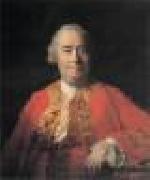 |
RAMSAY, Allan
|
|
Scottish Rococo Era Painter, 1713-1784
Portrait painter, born in Edinburgh, son of the poet Allan Ramsay. He studied in Edinburgh, London, Rome, and Naples, settling in London in 1739 and quickly establishing himself as the leading portraitist of the capital. He was particularly successful in painting women. His career as a portrait painter ended in 1773 |
|
|
|
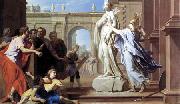 |
Rene-Antoine Houasse
|
|
(c. 1645 - 1710) was a decorative French painter.
He was a pupil of Charles Le Brun, under whose direction he worked at the Manufacture des Gobelins, and with whom he worked on the decoration of the Château de Versailles. He was the director of the French Academy in Rome from 1699 to 1704. His son was Michel-Ange Houasse, a painter of genre scenes.
|
|
 |
Reza Abbasi
|
|
(1565 - 1635) was the most renowned Persian miniaturist, painter and calligrapher of the Isfahan School, which flourished during the Safavid period under the patronage of Shah Abbas I.
He is considered to be one of the foremost Persian artists of all time. He received his training in the atelier of his father, Ali Asghar, and was received into the workshop of Shah Abbas I at a young age.
At the age of about 38 he received the honorific title of Abbasi from his patron, but soon left the Shah's employ, apparently seeking greater freedom to associate with simple people. In 1610 he returned to the court and continued in the employ of the Shah until his death.
His specialty was the Persian miniature, with a preference for naturalistic subjects often portrayed in an effeminate and impressionistic manner,a style which came to be popular during the late Safavid court. |
|
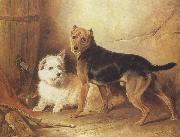 |
Richard ansdell,R.A.
|
|
1815-1885
English painter. He was the son of an artisan and in 1835 entered the Liverpool Academy Schools, where he later became president (1845-6). One of his earliest and largest dated works is the Waterloo Coursing Meeting (1.4*2.4 m, 1840; Liverpool, Walker A.G.). This canvas demonstrates his considerable skill as a portrait painter and creates a detailed record of a major sporting event of the period which was attended by many members of the local aristocracy, some of whom, notably the 3rd Earl of Sefton, were his patrons. It was engraved and published in 1843, and other works were similarly popularized. Shooting Party in the Highlands (1840; Liverpool, Walker A.G.) was the first of 149 works exhibited at the Royal Academy. It shows huntsmen with their horses and dogs resting after a good day's sport, a theme that Ansdell often depicted. He also portrayed other rural scenes such as gamekeepers or shepherds with domestic and wild animals, often in historical settings. All are painted with precision and sensitivity and without sentimentality. Although based in London from 1847 until 1884, Ansdell owned houses in Lancashire and Scotland and found inspiration in northern landscape. He travelled to Spain with the painter John Phillip in 1856 and alone in 1857 and produced several works of Spanish inspiration, for example Feeding Goats in the Alhambra (Preston, Harris Mus. & A.G.). He also collaborated with William Powell Frith and Thomas Creswick in rural genre scenes. Ansdell was commercially successful and was elected ARA in 1861 and RA in 1870. |
|
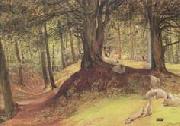 |
Richard Redgrave,RA
|
|
1804-1888
Painter, etcher and administrator, brother of (1) Samuel Redgrave. He trained initially as a clerk and draughtsman in his father's counting-house before becoming a student at the Royal Academy Schools in 1826; he also studied with John Powell. About 1830 he left his father's firm and supported himself as a drawing-master, working in watercolour before attempting to paint in oil. He exhibited at the Royal Academy from 1825 until failing eyesight afflicted him in 1883. He was elected ARA in 1840 and RA in 1851. |
|
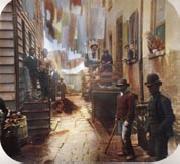 |
Riis Jacob August
|
|
Danish-American journalist and social reformer.
b.1849 d.1914
American photographer of Danish birth. The son of a school-teacher and editor, he was well-educated when he came to the USA in 1870. He was a self-taught photographer and worked at a variety of jobs before becoming a journalist, and he understood the power of the written and illustrated word. Riis's work in journalism began in 1873 when he was employed by the New York News Association. By 1874 he was editor and then owner of the South Brooklyn News. |
|
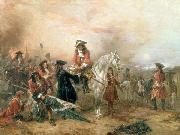 |
Robert Alexander Hillingford
|
|
(1825-1904) was an English painter. He specialized in historical pictures, often battle scenes.
Contents
He was born in London on January 28, 1828, and studied in Desseldorf in 1841 for five years and before traveling to Munich, Rome, Florence and Naples, where he married and worked for several years, producing paintings of Italian life. One painting from this period entitled The Last Evening of the Carnival was exhibited at St. Petersburg in 1859. He returned to London in 1864, and first exhibited at the Royal Academy in 1866; it was at this time that he began to work on historical subjects, especially of the Napoleonic Wars. He was a regular exhibitor at the Royal Academy, British Institution and at other galleries. While he was attracted to costume pieces such as An incident in the early life of Louis XIV and During the wanderings of Charles Edward Stuart', he also included some contemporary military scenes including his 1901 RA painting South Africa, 1901 - The Dawn of Peace.
Wellington at Waterloo
Lord Hill invites the last remnants of the French Imperial Guard to surrenderThe original paintings often come up at auction, and, with a large amount of the collection dispersed in 1998, the original paintings are widely scattered.
|
|
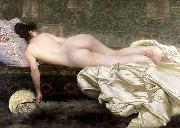 |
Rodolfo Amoedo
|
|
(born in Salvador, Bahia on December 11, 1857; died in Rio de Janeiro on May 31, 1941) was a Brazilian history painter. He began his career as an artist in 1873 as a student of Victor Meirelles. In 1878 he won the first prize at the Brazilian Academy, which allowed him to travel to Paris, where he lived from 1879 to 1887 studying at the École des Beaux Arts. He was a pupil of Alexandre Cabanel and also worked with Paul-Jacques-Aime Baudry. He was a professor and later director of the Brazilian Academy, renamed School of Fine Arts ou Escola Nacional de Belas Artes at the fall of the Brazilian Empire. His students include Eliseu Visconti. He died forgotten and so poor his friends had to help the widow pay for his funeral. His paintings still hang at the National Museum Museu Nacional de Belas Artes in Rio de Janeiro. |
|
|
|
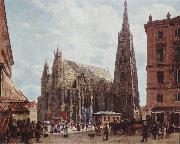 |
Rudolf von Alt
|
|
(28 August 1812 in Vienna C 12 March 1905 in Vienna) was an Austrian landscape and architectural painter. Borne as Rudolf Alt, he could call himself von Alt and bear the title of a Ritter (knight) after he gained nobility in 1882.
He was the son of the famous lithographer Jakob Alt (1789-1872). He studied at the Akademie der bildenden K??nste in Vienna. Hiking-trips through the Austrian Alps and northern Italy awoke a love for landscapes, and he painted with his brush using watercolors in a very realistic and detailed style. In 1833, inspired by a visit to Venice and neighbouring cities, he also made a number of architectural paintings.
Alt demonstrated a remarkable talent for expressing certain peculiarities in nature. He managed to paint nature authentically by focusing on the different hues of sky, the colour-tone of the air and the vegetation. His later works came closer to Impressionism. His perspectives on architecture were interesting, and he often chose everyday objects to paint. The painting of interior-views also became one of his strong points, giving him attention in Vienna. |
|
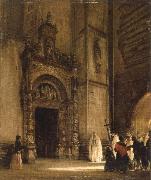 |
rudolph von alt
|
|
Rudolf Ritter von Alt (28 August 1812 in Vienna ?C 12 March 1905 in Vienna) was an Austrian landscape and architectural painter. Borne as Rudolf Alt, he could call himself von Alt and bear the title of a Ritter (knight) after he gained nobility in 1882.
He was the son of the famous lithographer Jakob Alt (1789-1872). He studied at the Akademie der bildenden K??nste in Vienna. Hiking-trips through the Austrian Alps and northern Italy awoke a love for landscapes, and he painted with his brush using watercolors in a very realistic and detailed style. In 1833, inspired by a visit to Venice and neighbouring cities, he also made a number of architectural paintings.
Alt demonstrated a remarkable talent for expressing certain peculiarities in nature. He managed to paint nature authentically by focusing on the different hues of sky, the colour-tone of the air and the vegetation. His later works came closer to Impressionism. His perspectives on architecture were interesting, and he often chose everyday objects to paint. The painting of interior-views also became one of his strong points, giving him attention in Vienna.
He visited and worked for a while in Rome and Naples; after that he visited the lakes of Lombardy, then Galicia, Bohemia, Dalmatia, Bavaria and then returned multiple times to Italy. In 1863 he went to the Crimea to paint some views of an estate of the Empress, and in 1867 he went to Sicily.
His younger brother Franz Alt, (b. 1821 in Vienna) was also a painter.
Most of his paintings are held by various museums in Vienna. The Albertina in Vienna hosted a retrospective exhibition from September 2005 to January 2006.
|
|
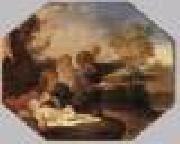 |
SACCHI, Andrea
|
|
Italian painter, Roman school (b. 1599, Nettuno, d. 1661, Roma).Italian painter and designer. He occupied an important position, midway between Annibale Carracci and Carlo Maratti, in the development of a more restrained, less decorative painting in 17th-century Rome, a trend that culminated in the 18th century with Pompeo Batoni. Sacchi trained with Francesco Albani, Carracci's student, and taught Maratti. His often expressed devotion to the art of Raphael and Carracci and his criticism of the views of Pietro da Cortona and Gianlorenzo Bernini made him, with Nicolas Poussin and Alessandro Algardi, one of the most significant representatives of a stylistic and aesthetic opposition to the more flamboyant, extrovert aspects of the High Baroque. Sacchi did not, however, share Poussin's passionate interest in Classical antiquity, nor was his mature work as cerebral. Yet his mature style, less richly coloured than his early manner and more restrained emotionally, |
|
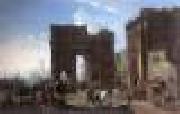 |
SALUCCI, Alessandro
|
|
Italian painter, Roman school (b. 1590, Firenze, d. 1655/60, Roma). Italian painter. He specialized in imaginary architectural perspectives and harbour views, in which the figures were executed by other artists, most notably Jan Miel and Michelangelo Cerquozzi. His pictures were praised by contemporary and near contemporary writers, including Carlo Malvasia, and during the 17th century were popular with private collectors in both Florence and Rome. However, many of the paintings mentioned in contemporary sources remain untraced. He is first documented in Rome in 1628, when, with Andrea Sacchi and Pietro da Cortona, he worked on the fresco decorations of the Villa Sacchetti (now Chigi), Castelfusano (nr Ostia), to which he contributed personifications of the River Nile and the River Rh?ne (in situ). He became a member of the Accademia di S Luca in Rome in 1634, and after 1635 he was engaged on frescoes (in situ) depicting sacred subjects in S Maria in Vallicella, Rome. From the mid-1630s onward Salucci collaborated with Miel on the imaginary architectural subjects for which he is best known, including the Perspective with Portico |
|
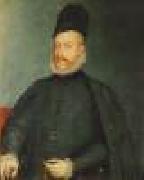 |
SANCHEZ COELLO, Alonso
|
|
Spanish Painter, ca.1531-1588
was a portrait painter of the Spanish Renaissance and one of the pioneers of the great tradition of Spanish portrait painting. Alonso Senchez Coello spent his childhood in Benifair de les Valls, until the death of his father when he was around ten years old. He was educated in Portugal at his grandfather's home. Coello's years in Portugal and his family name of Portuguese origin led to a long-standing belief that he was in fact Portuguese. His grandfather (after whom he was named) was in the service of King John III of Portugal who sent the young painter to study with Anthonis Mor (also known as Antonio Moro) in Flanders around 1550. He was under the service of Antoine de Granville, bishop of Arras, learning from Mor. While studying in Flanders, Coello also spent time copying some of Titian's works. In 1552, the painter went to Lisbon with Anthonis Mor when Charles V commissioned Mor to paint the Portuguese royal family. For a few years, Senchez Coello remained in Portugal working for the court of the heir to the throne, John, Crown Prince of Portugal. After the prince's death, Senchez Coello moved to the Spanish court of Philip II, having been recommended by the widow of John, Juana, who was the sister of the Spanish king. In 1555, S??nchez Coello was in Valladolid working for the Spanish court, and when Mor left Spain in 1561, Senchez Coello took his former master's place as Court Painter. Senchez Coello married Louisa Reyaltes in either 1560 or 1561 in Valladolid, and they had seven children. Coello's daughter, Isabel Senchez (1564-1612), |
|
|
|
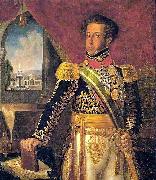 |
Santo angelo
|
|
(November 29, 1806 e December 30, 1879) was a Brazilian Romantic writer and painter, as well as an architect, diplomat and professor. He is patron of the 32nd chair of the Brazilian Academy of Letters.
Porto-alegre was born Manuel Jose de Araejo in Rio Pardo, to Francisco Jose de Araejo and Francisca Antônia Viana. He would change his name to Manuel de Araejo Pitangueira during the independence of Brazil, due to nativist causes. Later on, he finally changed it to its definitive form: Manuel de Araejo Porto-alegre.
In 1826, he moved to Rio de Janeiro, in order to study painting with Jean-Baptiste Debret at the Escola Nacional de Belas Artes. He also studied at what is now the Academia Militar das Agulhas Negras and took a Medicine course and Philosophy. In 1831, he left Brazil along with Debret to Europe, in order to improve his painting techniques. In 1835, he went to Italy, where he met Gonçalves de Magalhães, another Brazilian poet. He and Magalhães would create in France, in the year of 1837, a short-lived magazine named Niterei, alongside Francisco de Sales Torres Homem. Also in 1837, he becomes history painting teacher at the Escola Nacional de Belas Artes, in a post that would last until 1848, when he would become a drawing teacher at the Academia Militar das Agulhas Negras, and starts doing his first caricatures. In 1838, he married Ana Paulina Delamare, having with her two children: Carlota Porto-alegre (the future wife of painter Pedro Americo) and future diplomat Paulo Porto-alegre.
In 1840 he is named the official painter and decorator of Emperor Pedro II's palace. He decorated the imperial palace in Petrepolis, the wedding of Pedro II with Teresa Cristina of the Two Sicilies and the aforementioned emperor's coronation. He was decorated with the Order of Christ and the Order of the Rose.
Reuniting with Gonçalves de Magalhães and Torres Homem, he founded a periodic named Minerva Brasiliense, that lasted from 1843 to 1845. He would publish in this periodic his poem Brasiliana. In 1844, alongside Torres Homem, he founded the humoristic magazine Lanterna Megica, where he published his caricatures.
In 1849, Porto-alegre founded the magazine Guanabara, alongside Joaquim Manuel de Macedo and Gonçalves Dias. The magazine, considered the official journal of the Romantic movement in Brazil, lasted until 1856.
|
|
|
|
|
|
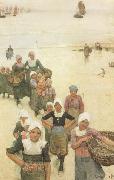 |
Sir George Clausen,RA
|
|
1852-1944
English painter. He was the son of a Danish interior decorator and a woman of Scottish descent. At 14 he was apprenticed to the drawing office of Messrs Trollope, a London firm of decorators. While working there he attended evening classes at the National Art Training School, South Kensington, but his first important artistic contact came when he was sent to decorate a door at the home of the painter Edwin Long. With Long's encouragement, Clausen obtained a two-year scholarship to the South Kensington School of Art and then decided to further his training at the Antwerp Academy. After studying briefly under Professor Joseph Van Lerius (1823-76), he began to sketch in the fishing villages along the Dutch coast; the product of these studies |
|
|
|
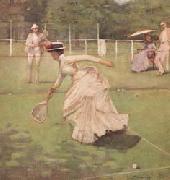 |
Sir John Lavery,RA
|
|
1856-1941
The artist John Lavery was born in Belfast, and studied in Scotland at the Glasgow School of Art from about 1874. He was in London from 1879-81 (he studied at Heatherley's School of Art for six months), and later in Paris, where he was influenced by Bastien-Lepage. He then returned to Glasgow, becoming a leading member of informal group of painters known as the Glasgow School (James Guthrie was another member), with work characterised by lack of a storyline, but great energy. Lavery achieved his pinnacle in the 1880s, with exhibitions in Europe and America, and as a leading portraitist, he was chosen to paint the State visit of Queen Victoria to the International Exhibition in Glasgow, 1888 - there were some 250 portraits in that picture. From 1890 he visited Morocco frequently, and he changed his British base to London in 1896, where he used a studio belonging to Alfred East. He was elected ARA in 1911, |
|
|
|
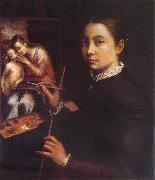 |
Sofonisba Anguisciola
|
|
1532?C1625, The best known of the sisters, she was trained, with Elena, by Campi and Gatti. Most of Vasari's account of his visit to the Anguissola family is devoted to Sofonisba, about whom he wrote: 'Anguissola has shown greater application and better grace than any other woman of our age in her endeavours at drawing; she has thus succeeded not only in drawing, colouring and painting from nature, and copying excellently from others, but by herself has created rare and very beautiful paintings'. Sofonisba's privileged background was unusual among woman artists of the 16th century, most of whom, like Lavinia Fontana (see FONTANA (ii),(2)), FEDE GALIZIA and Barbara Longhi (see LONGHI (i), (3)), were daughters of painters. Her social class did not, however, enable her to transcend the constraints of her sex. Without the possibility of studying anatomy, or drawing from life, she could not undertake the complex multi-figure compositions required for large-scale religious or history paintings. She turned instead to the models accessible to her, exploring a new type of portraiture with sitters in informal domestic settings. The influence of Campi, whose reputation was based on portraiture, is evident in her early works, such as the Self-portrait (Florence, Uffizi). Her work was allied to the worldly tradition of Cremona, much influenced by the art of Parma and Mantua, in which even religious works were imbued with extreme delicacy and charm. From Gatti she seems to have absorbed elements reminiscent of Correggio, beginning a trend that became marked in Cremonese painting of the late 16th century. |
|
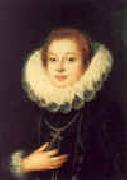 |
Sofonisba Anguissola
|
|
Italian
1532-1625
Sofonisba Anguissola was born in Cremona, Lombardy around 1532, the oldest of seven children, six of whom were daughters. Her father, Amilcare Anguissola, was a member of the Genoese minor nobility. Sofonisba's mother, Bianca Ponzone, was also of an affluent family of noble background. Her mother died when Sofonisba was four or five.
Over four generations, the Anguissola family had a strong connection to ancient Carthaginian history and they named their offspring after the great general Hannibal, thus the first daughter was named after the tragic Carthaginian figure Sophonisba.
Amilcare Anguissola encouraged all of his daughters (Sofonisba, Elena, Lucia, Europa, Minerva and Anna Maria) to cultivate and perfect their talents. Four of the sisters (Elena, Lucia, Europa and Anna Maria) became painters, but Sofonisba was by far the most accomplished and renowned. Elena became a nun (Sofonisba painted a portrait of her) and had to quit painting. Both Anna Maria and Europa gave up art upon marrying, while Lucia Anguissola, the best painter of Sophonisba's sisters, died young. The other sister, Minerva, became a writer and Latin scholar. Asdrubale, Sophonisba's brother, studied music and Latin but not painting.
Self-portrait, 1554Her aristocratic father made sure that Sofonisba and her sisters received a well-rounded education that included the fine arts. Anguissola was fourteen years old when her father sent her with her sister Elena to study with Bernardino Campi, a respected portrait and religious painter of the Lombard school, also from Cremona, Sofonisba's home town. When Campi moved to another city, Sofonisba continued her studies with the painter Bernardino Gatti (known as Il Sojaro). Sofonisba's apprenticeship with local painters set a precedent for women to be accepted as students of art.[citation needed] Dates are uncertain, but Anguissola probably continued her studies under Gatti for about three years(1551-1553).
Sophonisba's most important early work is Bernardino Campi Painting Sofonisba Anguissola (c 1550 Pinacoteca Nazionale, Siena). The double portrait depicts her art teacher in the act of painting a portrait of her.
In 1554, at age twenty-two, Sofonisba traveled to Rome, where she spent her time sketching various scenes and people. While in Rome, she met Michelangelo through the help of another painter who knew her work well. Meeting Michelangelo was a great honor for Sofonisba and she had the benefit of being informally trained by the great master.
Lucia, Minerva and Europa Anguissola Playing Chess, 1555. Museum Navrodwe, Poznan, Poland.When he made a request for her to draw a weeping boy, Sofonisba drew 'Child bitten by a crab' and sent it back to Michelangelo, who immediately recognized her talent (this sketch would continue to be discussed and copied for the next fifty years among artists and the aristocracy)
Michelangelo subsequently gave Anguissola sketches from his notebooks to draw in her own style and offered advice on the results. For at least two years Sofonisba continued this informal study, receiving substantial guidance from Michelangelo.
|
|
|
|
|
|
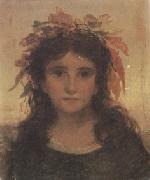 |
Sophie anderson
|
|
1823-1903
was a French-born British artist who specialised in genre painting of children and women, typically in rural settings. Her work is loosely associated with the Pre-Raphaelite movement. She was the daughter of Charles Gengembre, a Parisian architect, and his English wife. She was largely self-taught, but briefly studied portraiture with Charles de Steuben in Paris in 1843. The family left France for the United States to escape the 1848 revolution, They first lived in Cincinnati, Ohio, then in Manchester, Pennsylvania, where she met and married the British genre artist Walter Anderson. She initially worked in portraiture, including work for the chromolithographers Louis Prang & Co.. In 1854 the Andersons moved to London, where she exhibited her works in the Royal Academy. They returned to New York in 1858, then finally settled in London around 1863. Over the next three decades, her work was widely shown at venues including the Royal Academy, the Society of British Artists and many regional galleries. |
|
|
|
 |
Spinello Aretino
|
|
Italian Early Renaissance Painter, ca.1350-1410
was an Italian painter, the son of a Florentine named Luca, who had taken refuge in Arezzo in 1310 when exiled with the rest of the Ghibelline party. Spinello was a pupil of Jacopo del Casentino, a follower of Giotto, and his own style was a sort of link between the school of Giotto and that of Siena. In the early part of his life he worked in Florence as an assistant to his master Jacopo while painting frescoes in the church of the Carmine and in Santa Maria Novella. Between 1360 and 1384 he was occupied in painting many frescoes in and near Arezzo, almost all of which have now perished. After the sack of Arezzo in 1384 Spinello returned to Florence, and in 1387-1388 with some assistants covered the walls and vault of the sacristy of San Miniato of Florence with a series of frescoes, the chief of which represent scenes from the life of Saint Benedict. These still exist, though in a sadly restored condition; they are very Giotto-like in composition, but have some of the Siena decorative brilliance of color. In 1391-1392 Spinello was painting six frescoes, which still remain on the south wall of the Pisan Campo Santo, representing miracles of St. Potitus and St. Ephesus. For these he received 270 gold forms. Among his later works the chief are the very fine series of frescoes painted in 1407-1408 on the walls and vault of a chapel in the municipal buildings of Siena; these also have suffered much from repainting, but still are the finest of Spinello's existing frescoes. Sixteen of these represent the war of Frederick Barbarossa against the republic of Venice. |
|
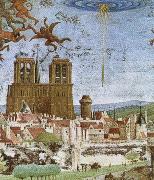 |
st ambrose
|
|
Milan; feast day December 7) Bishop of Milan. Raised in Rome, he became a Roman provincial governor. As a compromise candidate, he was unexpectedly elevated from unbaptized layman to bishop of Milan in 374. He established the medieval concept of the Christian emperor as subject to episcopal advice and censure when he forced the emperor Theodosius to seek forgiveness from the bishop, and he opposed tolerance for adherents of Arianism. He wrote theological treatises influenced by Greek philosophy, including On the Holy Spirit and On the Duties of Ministers, as well as a series of hymns. His brilliant sermons and personal example converted St. Augustine. |
|
|
|
 |
Tack Augustus Vincent
|
|
A painter of portraits, murals and abstractions.
American, 1870-1949
American, 1870-1949, was an American painter of portraits, landscapes and abstractions. He was born in Pittsburgh, Pennsylvania in 1870 and moved with his family to New York in 1883. After graduating from St. Francis Xavier College in New York City in 1890, Tack studied at the Art Students League of New York until 1895. He is believed to have frequented the studio of painter and stained glass designer John La Farge, whose portrait he painted around 1900. He had his first solo exhibition at the Kraushaar Galleries in New York City in 1896. The following year he moved to an artists?? colony in Deerfield, Massachusetts, where he met and later married Agnes Gordon Fuller, daughter of artist George Fuller. Tack maintained a studio in New York from 1894 until the end of his life. He had frequent exhibitions at New York City galleries. From 1900 until the 1920s his work was shown regularly at the Worcester Art Museum, at the Carnegie International exhibitions in Pittsburgh, and at the Pennsylvania Academy of the Fine Arts in Philadelphia. He taught at the Art Students League of New York between 1906 and 1910 and at Yale University from 1910 to 1913. About 1914 to 1915 his work attracted the notice of Duncan Phillips, who became his close friend and chief patron. Phillips and Tack also collaborated on the organization of the Allied War Salon of 1918. Tack died in 1949 in New York City. |
|
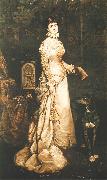 |
Tadeusz Ajdukiewicz
|
|
1852 in Wieliczka ?C January 9, 1916 in Krak??w) was a Polish painter.
From 1868 to 1873, he followed Władysław Luszczkiewicz classes in the Fine art school of Krakow. Later, he was in Vienna and Munich and in J??zef Brandt's atelier. In 1877, he travelled to Paris and Near East. In 1882, he lived in Vienna, where he worked for the aristocracy. In 1883, he went to London, where he made Prince of Wales' portrait. In 1884, to Constantinople, he was sultan Abdhulhamid II's guest. And he woked later in Sofia, Saint Petersburg and Bucharest. He joined the Polish Legions in 1914, during World War I, and he died in one of the battles of this war. He's first cousin was Zygmunt Ajdukiewicz. |
|
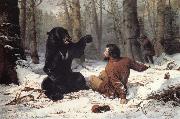 |
Tait Arthur Fitzwilliam
|
|
English-born American Painter, 1819-1905
American painter and lithographer of English birth. He spent the first three decades of his life in England and arrived in New York in 1850. Steeped in admiration for the subjects of Edwin Landseer and the style of the Pre-Raphaelites, he established himself as a realistic painter of animals and sporting scenes. For his images of Western hunters and trappers, he used as sources the works of George Catlin and William Ranney, artists who, unlike himself, had travelled extensively. He established a summer studio at a camp in the Adirondack Mountains, where he painted sporting scenes. These wilderness scenes, often composed around an anecdote, appealed to a wide popular audience, and from 1852 Currier & Ives as well as Louis Prang published a number of lithographs and chromolithographs of his work. Tait also composed still-lifes of game birds and, in his later career, barnyard scenes of sheep and chickens. His painting A Tight Fix: Bear Hunting in Early Winter |
|
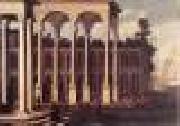 |
TASSI, Agostino
|
|
Italian painter, Roman school (b. 1578, Roma, d. 1644, Roma).
|
|
 |
Teodor Axentowicz
|
|
born May 13, 1859 in Braşov, Romania - August 26, 1938 in Krakew) was a Polish-Armenian painter and university professor. A renowned artist of his times, he was also the rector of the Academy of Fine Arts in Krakew. As an artist, Axentowicz was famous for his portraits and subtle scenes of Hutsul life, set in the Carpathians.
Axentowicz was born May 13, 1859 in Braşov, Hungary (now Romania), to a family of Polish-Armenian ancestry. In 1893 in Chelsea, London, he married Iza Henrietta Gielgud, aunt of Val Gielgud and John [Arthur] Gielgud of the theatrical dynasty. A son, Philip S.A.D. Axentowicz was born in Chelsea in 1893.
Between 1879 and 1882 he studied at the Academy of Fine Arts in Munich. From there he moved to Paris, where he continued his education until 1895. During that time he started a long-time cooperation with various journals and started his career as a copyist, duplicating the works of Tizian and Botticelli. He also made numerous travels to London and Rome, where he prepared a set of portraits, one of the first in his career.
|
|
|
|
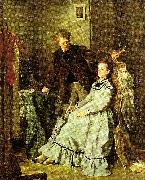 |
theodor alt
|
|
(Januar 1846 in Döhlau bei Hof (Oberfranken); 8. Oktober 1937 in Ansbach) war ein deutscher Maler.
Alt war der Sohn des Döhlauer Pastors Heinrich Alt und dessen Ehefrau Justina Ziegler. Nach erstem Unterricht durch seinen Vater besuchte Alt die Lateinschule in Regensburg, wo sein Vater von 1856 bis 1870 der evangelischen Gemeinde vorstand.
1861 wechselte er an die Kunstgewerbeschule N??rnberg, wo er als Schuler von Hans Ringlein bis 1863 blieb. Im Spatsommer desselben Jahres wechselte Alt mit Empfehlung seiner Lehrer an die Kunstakademie in M??nchen. Dort wurde er zuerst Sch??ler von Hermann Ansch??tz und in den Jahren 1866 bis 1873 bei Arthur von Ramberg. |
|
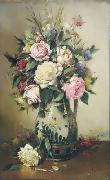 |
Theodor Aman
|
|
Theodor Aman (Romanian pronunciation: [teˈodor aˈman]; 20 March 1831, Câmpulung-Muscel-19 August 1891, Bucharest) was a Romanian painter of Armenian descent. His style is often considered to be a predecessor of Impressionism.
He is buried in Bellu cemetery.
|
|
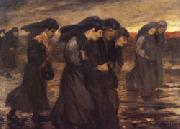 |
theophile-alexandre steinlen
|
|
Swiss-born French Art Nouveau Painter and Printmaker, 1859-1923
was a Swiss-born French Art Nouveau painter and printmaker. Born in Lausanne, Steinlen studied at the University of Lausanne before taking a job as a designer trainee at a textile mill in Mulhouse in eastern France. In his early twenties he was still developing his skills as a painter when he and his new wife were encouraged by the painter Francois Bocion to move to the artistic community in the Montmartre Quarter of Paris. Once there, Steinlen was befriended by the painter Adolphe Willette who introduced him the artistic crowd at Le Chat Noir that led to his commissions to do poster art for the cabaret owner/entertainer, Aristide Bruant and other commercial enterprises. La tournee du Chat Noir avec Rodolphe Salis (1896)In the early 1890s, Steinlen's paintings of rural landscapes, flowers, and nudes were being shown at the Salon des Independants. His 1895 lithograph titled Les Chanteurs des Rues was the frontispiece to a work entitled Chansons de Montmartre published by Editions Flammarion with sixteen original lithographs that illustrated the Belle Epoque songs of Paul Delmet. His permanent home, Montmartre and its environs was a favorite subject throughout Steinlen's life and he often painted scenes of some of the harsher aspects of life in the area. In addition to paintings and drawings, he also did sculpture on a limited basis, most notably figures of cats that he had great affection for as seen in many of his paintings. Steinlen became a regular contributor to Le Rire and Gil Blas magazines plus numerous other publications including L'Assiette au Beurre and Les Humouristes, a short-lived magazine he and a dozen other artists jointly founded in 1911. |
|
|
|
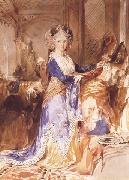 |
Thomas Allom
|
|
1804-1872
was an English artist, topographical illustrator and architect, and one of the founder members of what eventually became the Royal Institute of British Architects (RIBA).He was born in Lambeth, south London, the son of a coachman from Suffolk. In 1819, he was apprenticed to architect Francis Goodwin for whom he worked until 1826. He then studied at the Royal Academy School. His designs for churches shown at exhibitions in 1824 and 1827 aroused considerable interest, and he later designed many buildings in London (including a workhouse in Marloes Road, Kensington (1847), the Church of Christ in Highbury in 1850, the Church of St Peter's in Notting Hill in 1856, and the elegant Ladbroke Estate in west London). Further afield his works included workhouses at Calne, Wiltshire (1847) and in Liverpool, design of the William Brown Library also in Liverpool, (1857-1860), and the tower of St. Leodegarius Church, Basford near Nottingham (1860). |
|
|

